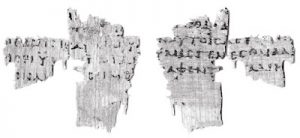O debate sobre o fragmento de Marcos voltou.
Do que se trata?
Especialistas avaliam que o P137 foi escrito entre 150 e 250 d.C. O manuscrito mede apenas 4,4 x 4 cm, e contém algumas letras dos versículos 7–9 e 16–18 do capítulo 1 do evangelho de Marcos. Mesmo que não seja tão antigo quanto muitos esperavam – fora divulgado que seria do século I -, o P137 ainda é uma descoberta significativa, pois é provável que este seja o mais antigo fragmento do evangelho de Marcos até agora descoberto.
Para entender o caso, três posts podem ser lidos:
Descoberto fragmento de Marcos do século I?
Esclarecimentos sobre o fragmento de Marcos do século I
Fragmento de Marcos foi escrito entre 150 e 250 d.C.
Jim West fez um apanhado das várias intervenções no Biblical Studies Carnival 160, publicado ontem. É preciso conferir o original para os links. Ele diz:
So called ‘First Century’ Mark has returned… blerg. It is worth noting that the Green Collection, though having received title to the fragments (see point 10 of the purchase agreement), never took physical possession of the fragments. Instead, in accordance with other terms of the agreement (see points 10.1-10.2) the fragments were left in Obbink’s custody for research and publication (the intended venue of initial publication being specified in 10.3). You’ll have to read the post and its attachments to figure out what all that is supposed to mean. Blerg.
Larry Hurtado writes in connection with the scandal (this is as close to scandal as scholarship gets, unless you count Richard Pervo…): This new evidence is personally dismaying, as it raises questions about the actions of Obbink, in whom I placed trust earlier (as in my blog posting here). It now appears that my confidence may have been misplaced. In a comment on Nongbri’s posting [NB- It’s actually a comment on Elijah Hixson’s post, not Nongbri’s][JW], Peter Head says these developments now make me and Ehrman look “stupid”. I’m not clear how he reached that judgment. I may have been mistaken in my trust in Obbink, but trusting someone until there is reason to think otherwise is hardly stupid, Peter. Also chiming in is Elijah Hixson over on ETC. Enjoy the comments there too.
But the best analysis of the whole debacle is by Bart Ehrman. His take is here. And his response to demonstrably false claims and statements is here.
And then there’s this analysis of the receipt for the documents. Gonzo work! This first century (not) Mark thing will be made into a mystery film before long. I suggest ‘On the Trail of Mark: Fraud for Profit’…
But if you want a more Obbink friendly take on the whole thing, don’t worry. There’s this guy. He seems to think the whole thing is a setup…. And Larry Hurtado thinks the fragment probative. Allow me to remind you, however, that it is unprovenanced.
And, finally, as the month drew to a close, this shows up in Christianity Today. What a bunch of shady characters doing shady things. And worst of all, they knew they were.
Whew… That’s a lot of talk about an unprovenanced trinket. Hey, you know how these problems and scandals can be avoided in the future? Scholars can decide to have NOTHING to do with anything unprovenanced! ‘Oh, hey Bob, you have a trinket you think is ancient and you want me to stake my reputation on it but you got it from some dude in a back alley? Nah, hard pass, dude. You go ruin your reputation, I think I’ll keep mine’.
A isto acrescento algo que li hoje no blog Kiwi Hellenist e que nos ajuda a entender o imbróglio de 1903 até 29 de junho de 2019: The ‘FCM’ scandal: a timeline.
